2019 DODGE CHALLENGER SRT flat tire
[x] Cancel search: flat tirePage 376 of 500

Tread Wear Indicators
Tread wear indicators are in the original equipment tires to
help you in determining when your tires should be re-
placed.These indicators are molded into the bottom of the tread
grooves. They will appear as bands when the tread depth
becomes a 1/16 of an inch (1.6 mm). When the tread is
worn to the tread wear indicators, the tire should be
replaced.
Refer to “Replacement Tires” in this section for further
information.
Life Of Tire
The service life of a tire is dependent upon varying factors
including, but not limited to:
•
Driving style.
• Tire pressure - Improper cold tire inflation pressures can
cause uneven wear patterns to develop across the tire
tread. These abnormal wear patterns will reduce tread
life, resulting in the need for earlier tire replacement.
• Distance driven.
• Performance tires, tires with a speed rating of V or
higher, and Summer tires typically have a reduced tread
life. Rotation of these tires per the vehicle scheduled
maintenance is highly recommended.
Tire Tread
1—WornTire
2—NewTire 374 SERVICING AND MAINTENANCE
Page 377 of 500
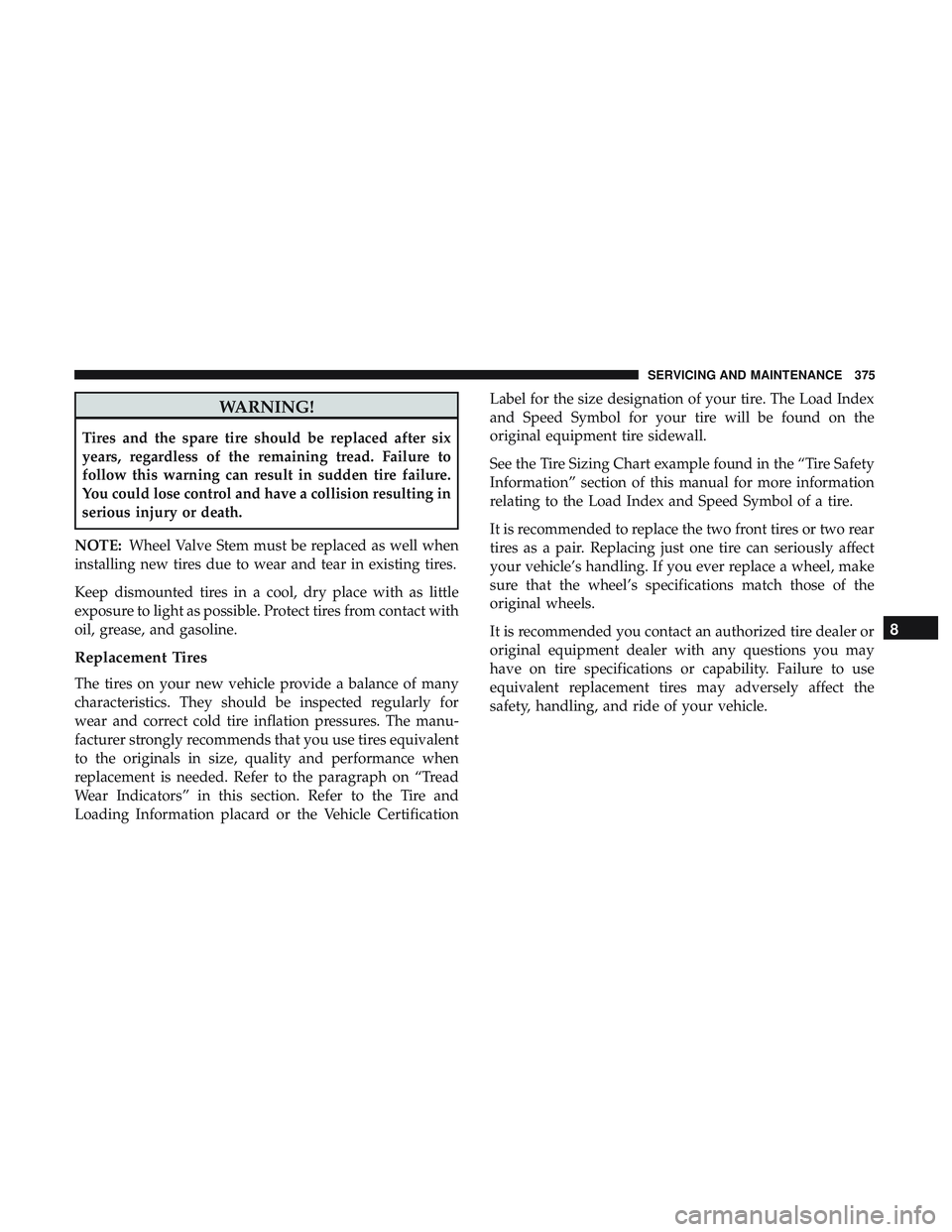
WARNING!
Tires and the spare tire should be replaced after six
years, regardless of the remaining tread. Failure to
follow this warning can result in sudden tire failure.
You could lose control and have a collision resulting in
serious injury or death.
NOTE: Wheel Valve Stem must be replaced as well when
installing new tires due to wear and tear in existing tires.
Keep dismounted tires in a cool, dry place with as little
exposure to light as possible. Protect tires from contact with
oil, grease, and gasoline.
Replacement Tires
The tires on your new vehicle provide a balance of many
characteristics. They should be inspected regularly for
wear and correct cold tire inflation pressures. The manu-
facturer strongly recommends that you use tires equivalent
to the originals in size, quality and performance when
replacement is needed. Refer to the paragraph on “Tread
Wear Indicators” in this section. Refer to the Tire and
Loading Information placard or the Vehicle Certification Label for the size designation of your tire. The Load Index
and Speed Symbol for your tire will be found on the
original equipment tire sidewall.
See the Tire Sizing Chart example found in the “Tire Safety
Information” section of this manual for more information
relating to the Load Index and Speed Symbol of a tire.
It is recommended to replace the two front tires or two rear
tires as a pair. Replacing just one tire can seriously affect
your vehicle’s handling. If you ever replace a wheel, make
sure that the wheel’s specifications match those of the
original wheels.
It is recommended you contact an authorized tire dealer or
original equipment dealer with any questions you may
have on tire specifications or capability. Failure to use
equivalent replacement tires may adversely affect the
safety, handling, and ride of your vehicle.
8
SERVICING AND MAINTENANCE 375
Page 379 of 500
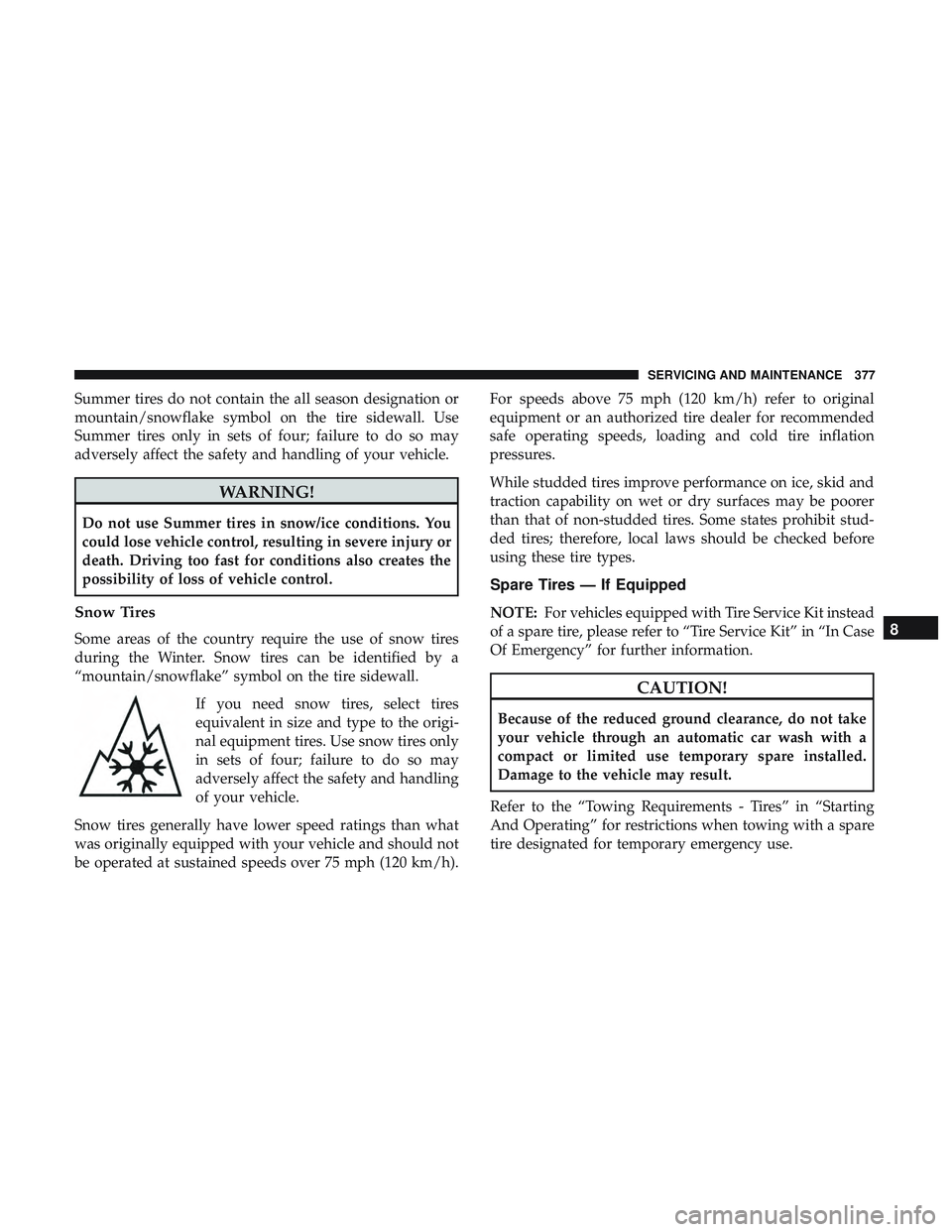
Summer tires do not contain the all season designation or
mountain/snowflake symbol on the tire sidewall. Use
Summer tires only in sets of four; failure to do so may
adversely affect the safety and handling of your vehicle.
WARNING!
Do not use Summer tires in snow/ice conditions. You
could lose vehicle control, resulting in severe injury or
death. Driving too fast for conditions also creates the
possibility of loss of vehicle control.
Snow Tires
Some areas of the country require the use of snow tires
during the Winter. Snow tires can be identified by a
“mountain/snowflake” symbol on the tire sidewall.If you need snow tires, select tires
equivalent in size and type to the origi-
nal equipment tires. Use snow tires only
in sets of four; failure to do so may
adversely affect the safety and handling
of your vehicle.
Snow tires generally have lower speed ratings than what
was originally equipped with your vehicle and should not
be operated at sustained speeds over 75 mph (120 km/h). For speeds above 75 mph (120 km/h) refer to original
equipment or an authorized tire dealer for recommended
safe operating speeds, loading and cold tire inflation
pressures.
While studded tires improve performance on ice, skid and
traction capability on wet or dry surfaces may be poorer
than that of non-studded tires. Some states prohibit stud-
ded tires; therefore, local laws should be checked before
using these tire types.
Spare Tires — If Equipped
NOTE:
For vehicles equipped with Tire Service Kit instead
of a spare tire, please refer to “Tire Service Kit” in “In Case
Of Emergency” for further information.
CAUTION!
Because of the reduced ground clearance, do not take
your vehicle through an automatic car wash with a
compact or limited use temporary spare installed.
Damage to the vehicle may result.
Refer to the “Towing Requirements - Tires” in “Starting
And Operating” for restrictions when towing with a spare
tire designated for temporary emergency use.
8
SERVICING AND MAINTENANCE 377
Page 381 of 500
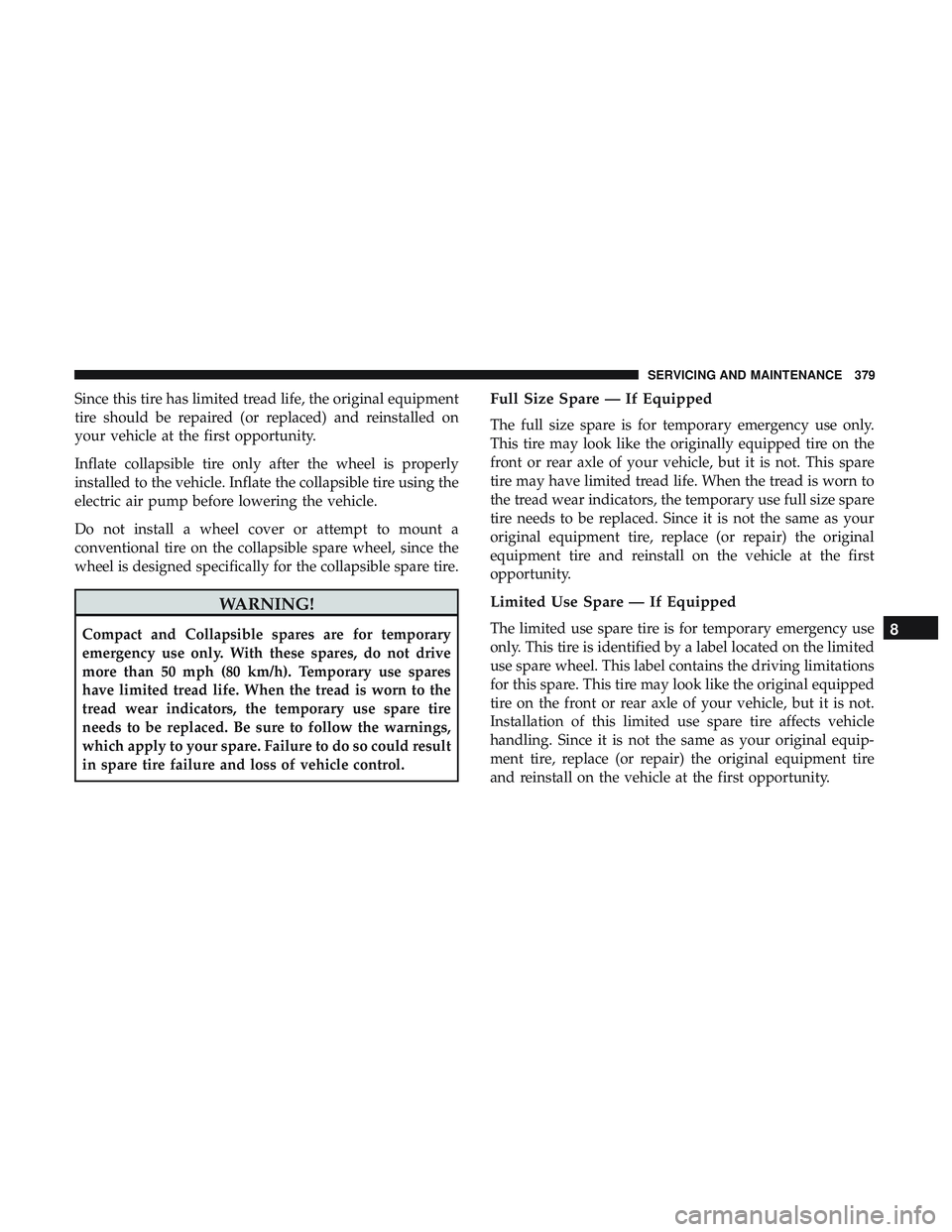
Since this tire has limited tread life, the original equipment
tire should be repaired (or replaced) and reinstalled on
your vehicle at the first opportunity.
Inflate collapsible tire only after the wheel is properly
installed to the vehicle. Inflate the collapsible tire using the
electric air pump before lowering the vehicle.
Do not install a wheel cover or attempt to mount a
conventional tire on the collapsible spare wheel, since the
wheel is designed specifically for the collapsible spare tire.
WARNING!
Compact and Collapsible spares are for temporary
emergency use only. With these spares, do not drive
more than 50 mph (80 km/h). Temporary use spares
have limited tread life. When the tread is worn to the
tread wear indicators, the temporary use spare tire
needs to be replaced. Be sure to follow the warnings,
which apply to your spare. Failure to do so could result
in spare tire failure and loss of vehicle control.
Full Size Spare — If Equipped
The full size spare is for temporary emergency use only.
This tire may look like the originally equipped tire on the
front or rear axle of your vehicle, but it is not. This spare
tire may have limited tread life. When the tread is worn to
the tread wear indicators, the temporary use full size spare
tire needs to be replaced. Since it is not the same as your
original equipment tire, replace (or repair) the original
equipment tire and reinstall on the vehicle at the first
opportunity.
Limited Use Spare — If Equipped
The limited use spare tire is for temporary emergency use
only. This tire is identified by a label located on the limited
use spare wheel. This label contains the driving limitations
for this spare. This tire may look like the original equipped
tire on the front or rear axle of your vehicle, but it is not.
Installation of this limited use spare tire affects vehicle
handling. Since it is not the same as your original equip-
ment tire, replace (or repair) the original equipment tire
and reinstall on the vehicle at the first opportunity.8
SERVICING AND MAINTENANCE 379
Page 382 of 500
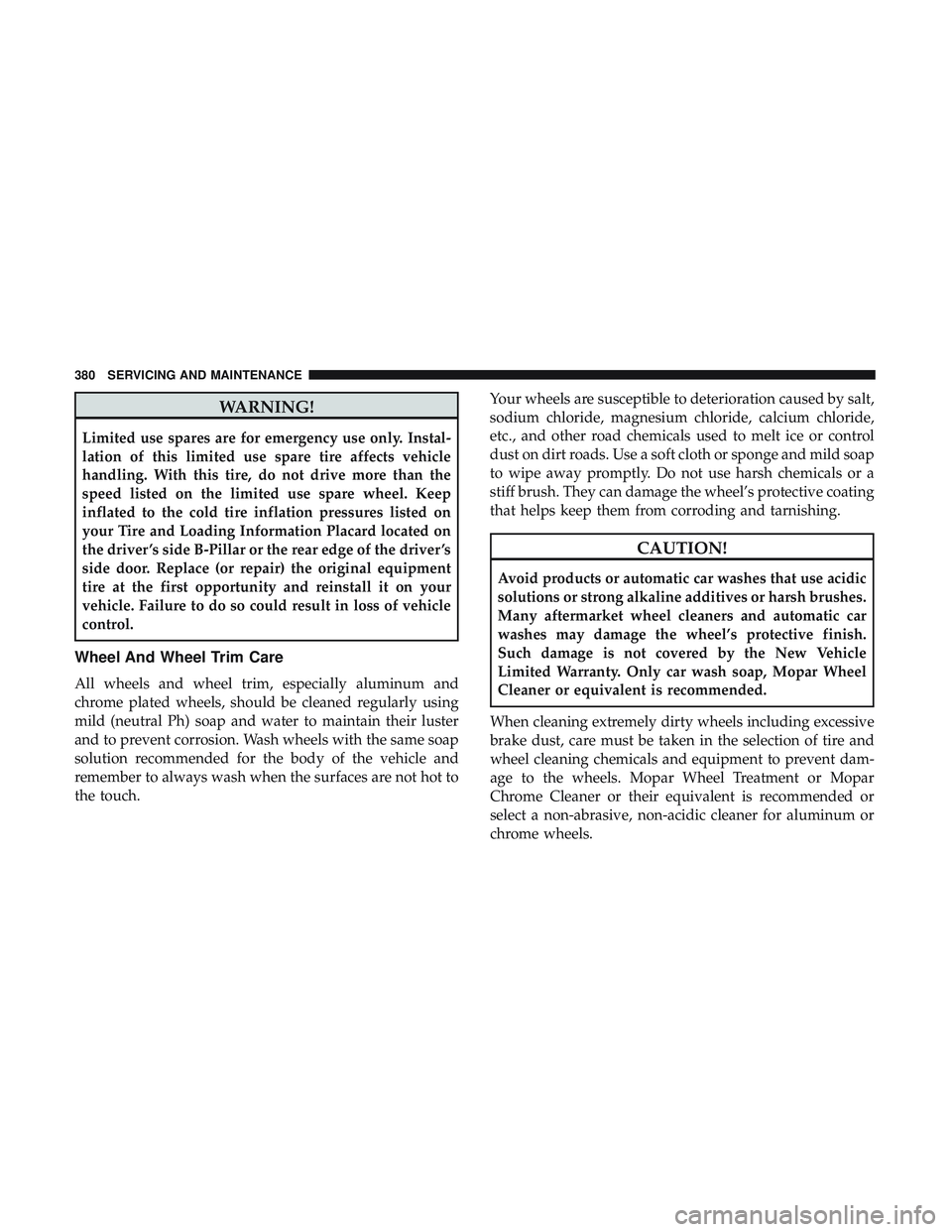
WARNING!
Limited use spares are for emergency use only. Instal-
lation of this limited use spare tire affects vehicle
handling. With this tire, do not drive more than the
speed listed on the limited use spare wheel. Keep
inflated to the cold tire inflation pressures listed on
your Tire and Loading Information Placard located on
the driver ’s side B-Pillar or the rear edge of the driver ’s
side door. Replace (or repair) the original equipment
tire at the first opportunity and reinstall it on your
vehicle. Failure to do so could result in loss of vehicle
control.
Wheel And Wheel Trim Care
All wheels and wheel trim, especially aluminum and
chrome plated wheels, should be cleaned regularly using
mild (neutral Ph) soap and water to maintain their luster
and to prevent corrosion. Wash wheels with the same soap
solution recommended for the body of the vehicle and
remember to always wash when the surfaces are not hot to
the touch.Your wheels are susceptible to deterioration caused by salt,
sodium chloride, magnesium chloride, calcium chloride,
etc., and other road chemicals used to melt ice or control
dust on dirt roads. Use a soft cloth or sponge and mild soap
to wipe away promptly. Do not use harsh chemicals or a
stiff brush. They can damage the wheel’s protective coating
that helps keep them from corroding and tarnishing.
CAUTION!
Avoid products or automatic car washes that use acidic
solutions or strong alkaline additives or harsh brushes.
Many aftermarket wheel cleaners and automatic car
washes may damage the wheel’s protective finish.
Such damage is not covered by the New Vehicle
Limited Warranty. Only car wash soap, Mopar Wheel
Cleaner or equivalent is recommended.
When cleaning extremely dirty wheels including excessive
brake dust, care must be taken in the selection of tire and
wheel cleaning chemicals and equipment to prevent dam-
age to the wheels. Mopar Wheel Treatment or Mopar
Chrome Cleaner or their equivalent is recommended or
select a non-abrasive, non-acidic cleaner for aluminum or
chrome wheels.
380 SERVICING AND MAINTENANCE
Page 386 of 500
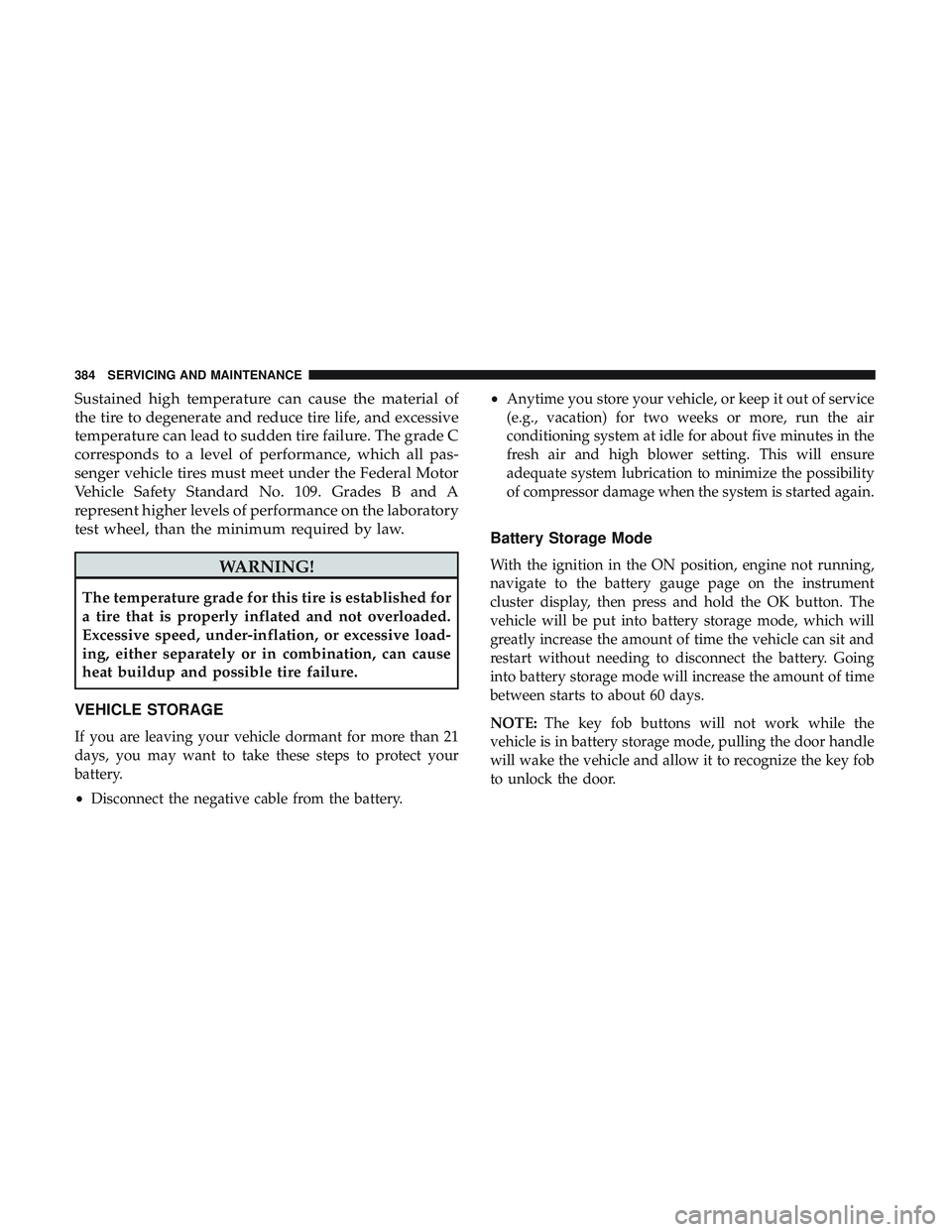
Sustained high temperature can cause the material of
the tire to degenerate and reduce tire life, and excessive
temperature can lead to sudden tire failure. The grade C
corresponds to a level of performance, which all pas-
senger vehicle tires must meet under the Federal Motor
Vehicle Safety Standard No. 109. Grades B and A
represent higher levels of performance on the laboratory
test wheel, than the minimum required by law.
WARNING!
The temperature grade for this tire is established for
a tire that is properly inflated and not overloaded.
Excessive speed, under-inflation, or excessive load-
ing, either separately or in combination, can cause
heat buildup and possible tire failure.
VEHICLE STORAGE
If you are leaving your vehicle dormant for more than 21
days, you may want to take these steps to protect your
battery.
• Disconnect the negative cable from the battery. •
Anytime you store your vehicle, or keep it out of service
(e.g., vacation) for two weeks or more, run the air
conditioning system at idle for about five minutes in the
fresh air and high blower setting. This will ensure
adequate system lubrication to minimize the possibility
of compressor damage when the system is started again.
Battery Storage Mode
With the ignition in the ON position, engine not running,
navigate to the battery gauge page on the instrument
cluster display, then press and hold the OK button. The
vehicle will be put into battery storage mode, which will
greatly increase the amount of time the vehicle can sit and
restart without needing to disconnect the battery. Going
into battery storage mode will increase the amount of time
between starts to about 60 days.
NOTE: The key fob buttons will not work while the
vehicle is in battery storage mode, pulling the door handle
will wake the vehicle and allow it to recognize the key fob
to unlock the door.
384 SERVICING AND MAINTENANCE
Page 486 of 500
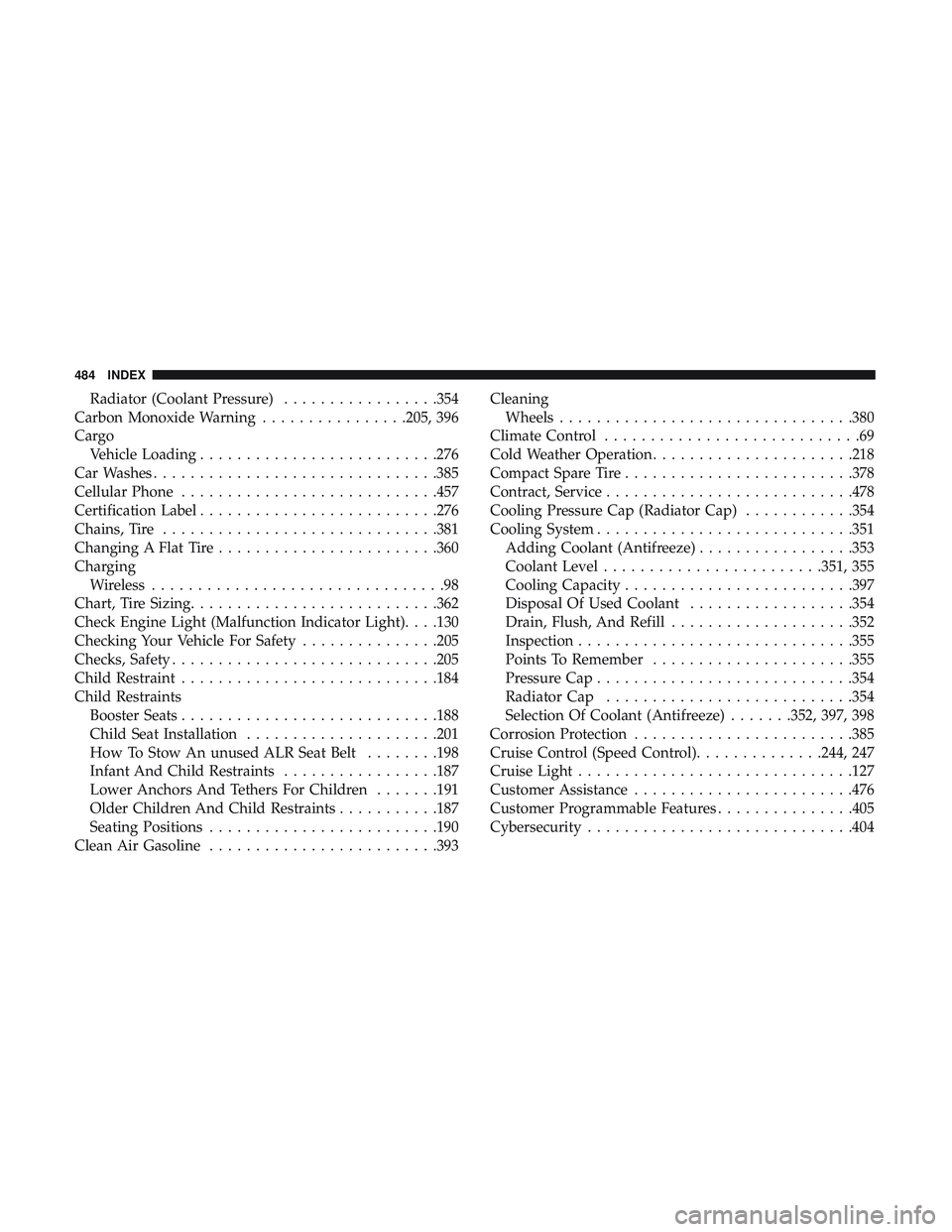
Radiator (Coolant Pressure).................354
Carbon Monoxide Warning ................205, 396
Cargo Vehicle Loading ..........................276
Car Washes ...............................385
Cellular Phone ............................457
Certification Label ..........................276
Chains, Tire ............................. .381
Changing A Flat Tire ........................360
Charging Wireless ................................98
Chart, Tire Sizing .......................... .362
Check Engine Light (Malfunction Indicator Light). . . .130
Checking Your Vehicle For Safety ...............205
Checks, Safety ............................ .205
Child Restraint ............................184
Child Restraints Booster Seats ............................188
Child Seat Installation .....................201
How To Stow An unused ALR Seat Belt ........198
Infant And Child Restraints .................187
Lower Anchors And Tethers For Children .......191
Older Children And Child Restraints ...........187
Seating Positions ........................ .190
Clean Air Gasoline ........................ .393Cleaning
Wheels ............................... .380
Climate Control ............................69
Cold Weather Operation ..................... .218
Compact Spare Tire ........................ .378
Contract, Service .......................... .478
Cooling Pressure Cap (Radiator Cap) ............354
Cooling System ............................351
Adding Coolant (Antifreeze) .................353
Coolant Level ........................351, 355
Cooling Capacity ........................ .397
Disposal Of Used Coolant ..................354
Drain, Flush, And Refill ....................352
Inspection ............................. .355
Points T
o Remember ..................... .355
Pressure Cap ............................354
Radiator Cap .......................... .354
Selection Of Coolant (Antifreeze) .......352, 397, 398
Corrosion Protection ........................385
Cruise Control (Speed Control) ..............244, 247
Cruise Light ............................. .127
Customer Assistance ........................476
Customer Programmable Features ...............405
Cybersecurity ............................ .404
484 INDEX
Page 496 of 500
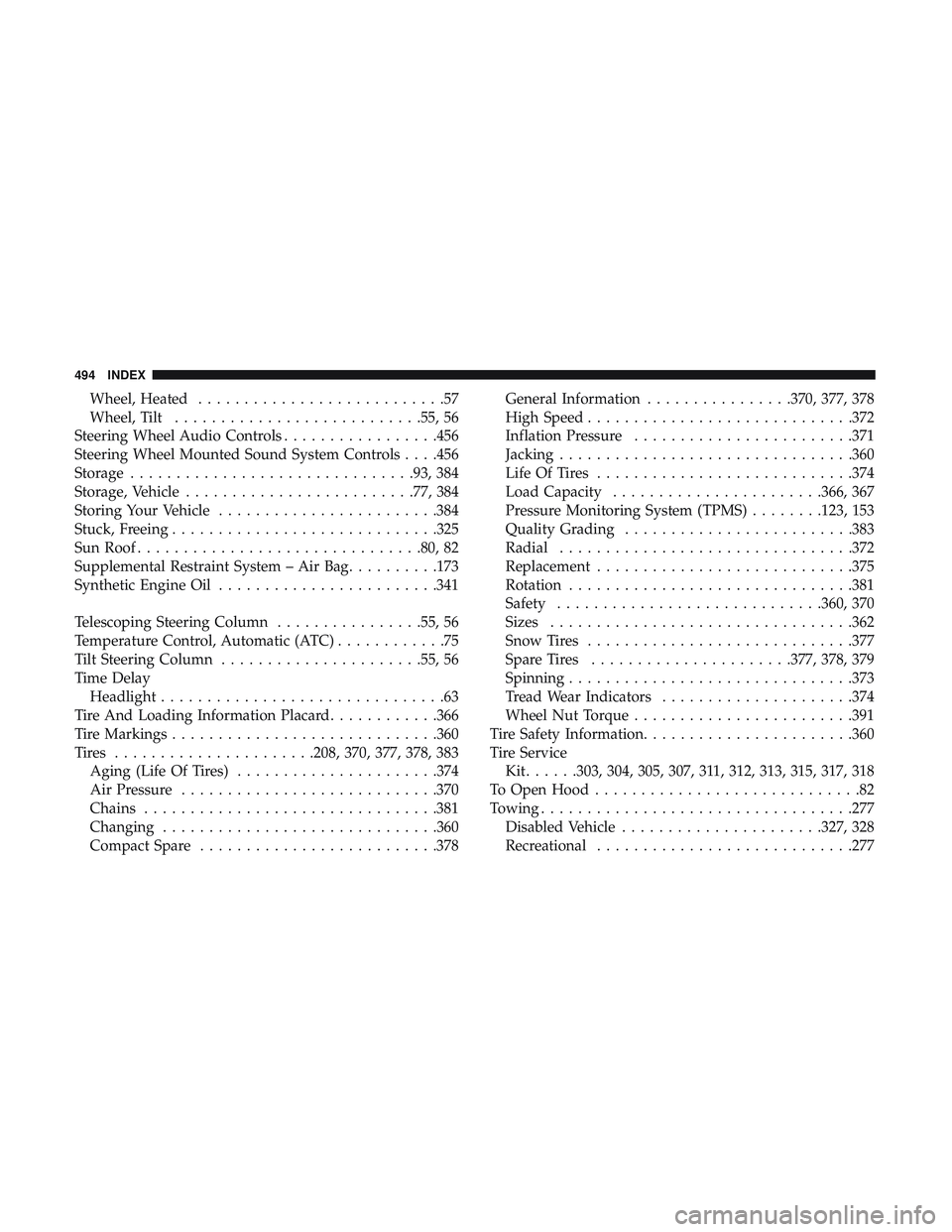
Wheel, Heated...........................57
Wheel, Tilt .......................... .55, 56
Steering Wheel Audio Controls .................456
Steering Wheel Mounted Sound System Controls . . . .456
Storage ...............................93, 384
Storage, Vehicle ........................ .77, 384
Storing Your Vehicle ........................384
Stuck, Freeing ............................ .325
Sun Roof ...............................80, 82
Supplemental Restraint System – Air Bag ..........173
Synthetic Engine Oil ........................341
Telescoping Steering Column ................55, 56
Temperature Control, Automatic (ATC) ............75
Tilt Steering Column ..................... .55, 56
Time Delay Headlight ...............................63
Tire And Loading Information Placard ............366
Tire Markings ............................ .360
Tires ......................208, 370, 377, 378, 383 Aging (Life Of Tires) ..................... .374
Air Pressure ............................370
Chains ............................... .381
Changing ............................. .360
Compact Spare ..........................378 General Information
................370, 377, 378
High Speed ............................ .372
Inflation Pressure ........................371
Jacking ............................... .360
Life Of Tires ............................374
Load Capacity .......................366, 367
Pressure Monitoring System (TPMS) ........123, 153
Quality Grading ........................ .383
Radial ............................... .372
Replacement ............................375
Rotation ...............................381
Safety ............................ .360, 370
Sizes .................................362
Snow T
ires............................ .377
Spare Tires ..................... .377, 378, 379
Spinning ...............................373
Tread Wear Indicators .....................374
Wheel Nut Torque ........................391
Tire Safety Information .......................360
Tire Service Kit......303, 304, 305, 307, 311, 312, 313, 315, 317, 318
To Open Hood .............................82
Towing ................................. .277
Disabled Vehicle ..................... .327, 328
Recreational ............................277
494 INDEX